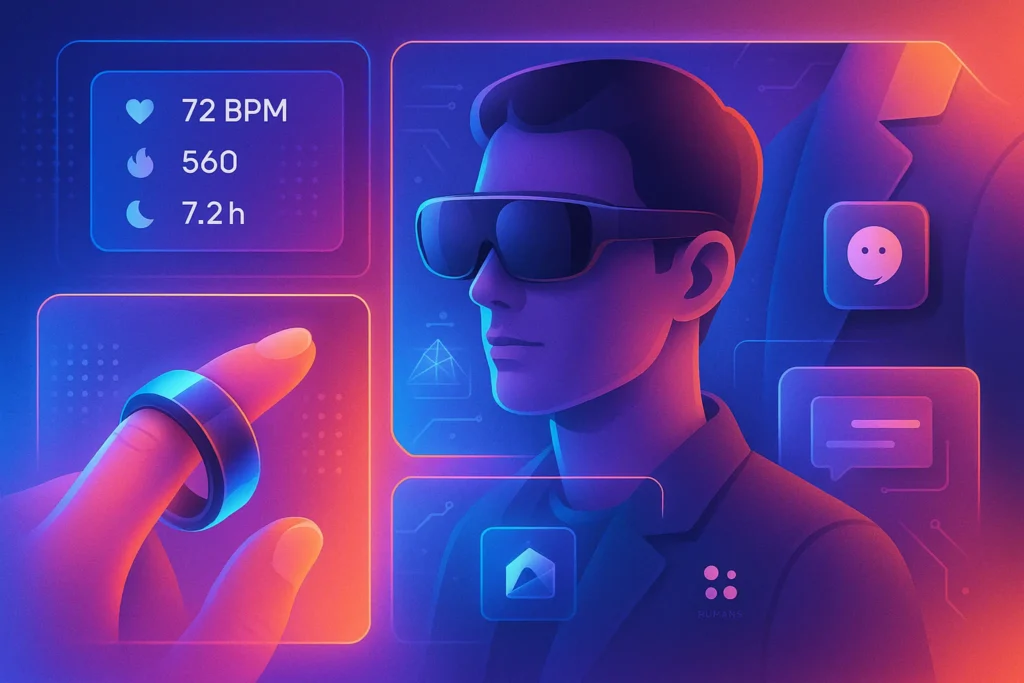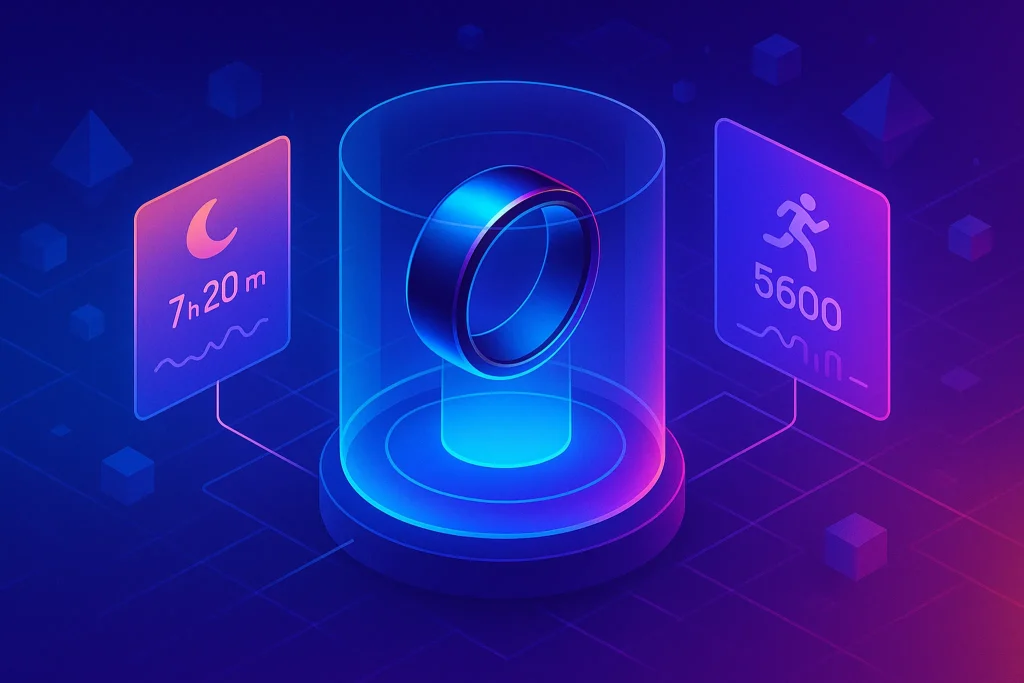-This post may contain affiliate links. If you click on one and make a purchase, I may earn a small commission at no extra cost to you.-
Introduction
In 2025, wearable tech and AI gadgets are stepping out of smartphones’ shadows to deliver seamless, intelligent experiences directly on your body. These devices integrate health monitoring, gesture controls, and immersive augmented reality—no pocket needed. If you’re curious how smart rings, advanced AR glasses, and AI-powered wearables are reshaping daily life—from fitness insights to hands-free spatial computing—this article is for you. We’ll break down top gadgets, real-world use cases, and practical buying advice. Plus, get a glimpse of what’s ahead in this rapidly evolving landscape.
As we explored in From Sci‑Fi to Reality: Top Futuristic Gadgets You Can Own Now earlier, gadgets are increasingly converging with fashion and AI. Today, we dive deeper with tools that do more than just tell time—they think, sense, and blend into your routine. And if you’re planning a connected lifestyle, check out The Ultimate Smart Home Setup Guide: Gadgets, Tips, and Tricks for syncing these wearables with your home ecosystem.
🎯 Evaluation Criteria
We assessed each gadget based on:
-
Sensor accuracy & health tracking
-
AI intelligence & insights
-
Comfort, battery life, and wearability
-
Daily integration convenience
-
Price-to-value ratio
Top AI-Powered Wearables of 2025
1. Oura Ring 4
The Oura Ring 4 isn’t just another health tracker—it’s a miniaturized wellness lab that wraps around your finger. This smart ring has become a go-to for people looking to monitor their sleep quality, recovery metrics, stress levels, and overall health without the bulk of a smartwatch. With its medical-grade sensors, it can continuously track heart rate, temperature fluctuations, and blood oxygen saturation. But where Oura really shines is its AI-powered readiness score, which tells you each morning whether your body is primed for activity or needs recovery.
Its slim, lightweight design makes it ideal for 24/7 wear, including sleep, and the ring is waterproof, so you never need to take it off. Whether you’re managing health conditions like POTS, optimizing athletic performance, or simply trying to stay ahead of burnout, Oura gives you actionable insights—not just raw data. The companion app is intuitive, and the analytics it provides are rooted in real sleep science and HRV studies.
However, it’s not perfect. Unlike a smartwatch, it doesn’t give real-time workout feedback, and its monthly subscription (currently $5.99) may be a dealbreaker for some. Still, for users prioritizing accurate, passive health monitoring without distractions, the Oura Ring 4 is a clear winner.
-
Real Use Case: Continuous sleep and stress monitoring for medical conditions like POTS.
-
Key Features:
-
8-day battery life (real-world ~6 days)
-
Medical-grade biometric sensors (HR, temperature, HRV)
-
AI-driven recovery & readiness scores
-
-
Pros & Cons:
-
✅ Sleek, discreet, long battery
-
❌ Lacks real-time workout metrics, $349 + $5.99/mo membership
-
-
Pricing: from $349, warranty + 30-day return
-
📢 Track your health discreetly—[Buy the Oura Ring 4].
2. Xreal One Pro AR Glasses
The Xreal One Pro represents one of the most exciting leaps in consumer-grade AR technology in 2025. These smart glasses turn any space—your desk, couch, or even airplane seat—into a multi-screen AR environment, thanks to its high-resolution Micro-OLED displays and 57-degree field of view. With a 120Hz refresh rate and vibrant visuals, they offer a truly immersive experience for watching videos, browsing content, or working across multiple virtual windows.
But Xreal isn’t just about visuals. Built-in spatial anchors and six degrees of freedom (6DoF) tracking mean these glasses understand your environment. You can pin a floating display in one corner of your room and it’ll stay locked in place, even as you move around—making it a dream for multitaskers and mobile professionals. It connects easily via USB-C and supports a wide range of devices, including laptops, gaming consoles, and some smartphones.
Comfort-wise, Xreal One Pro is surprisingly ergonomic, with adjustable nose pads and balanced weight distribution. The Bose-engineered directional speakers provide decent audio without isolating you from the world—perfect for blending real and virtual environments. On the downside, the glasses require tethering to an external power source, and the short USB-C cable included may limit mobility.
Still, for users wanting a portable virtual workspace, immersive media consumption, or cutting-edge AR tools, the Xreal One Pro delivers a feature-packed punch.
-
Real Use Case: Transform any space into a virtual display—ideal for travel productivity and immersive gaming.
-
Key Features:
-
Sony Micro‑OLED, 120 Hz refresh, 57° FOV
-
Built-in Bose audio, plug-and-play via USB‑C
-
6DoF spatial anchor enables floating AR screens
-
-
Pros & Cons:
-
✅ Smooth visuals, customizable fit, immersive display
-
❌ Expensive (~$649), short USB‑C cable, occasional software quirks
-
-
Pricing: Launch price $599–649
-
📢 Elevate your workspace—[Get Xreal One Pro].
3. Meta Orion AR Glasses (Prototype)
The Meta Orion AR Glasses are still in prototype stage, but they’ve already captured the imagination of futurists and tech enthusiasts. Designed to completely replace the smartphone, Orion aims to deliver a true hands-free computing experience—not just through visuals, but through intelligent contextual AI. What sets these glasses apart is the EMG-based neural wristband, which allows users to control the interface using subtle finger movements, essentially turning gestures into commands without lifting a hand.
Imagine walking into your kitchen, and the glasses automatically display a recipe on the counter, suggest substitutes based on what you have, and track your progress—all while you cook. That’s the level of ambient intelligence Meta envisions. With micro projectors and advanced sensors, the Orion blends digital overlays into your real environment, making screens and keyboards obsolete.
Visually, the device is minimalist and designed to resemble traditional glasses, which is a step forward in making AR socially acceptable in everyday contexts. However, as a prototype, it’s not commercially available yet, and important factors like comfort during long use, battery life, and real-world durability are still unknown.
Still, Orion gives us a thrilling glimpse of what the next evolution of personal computing might look like—where the AI doesn’t just assist, but anticipates and reacts in real time.
-
Real Use Case: Hands-free AR with AI—ideal for immersive and ambient computing.
-
Key Features:
-
EMG wristband for gesture control
-
MicroLED projectors and tiny sensors
-
AI assistant reveals info about surroundings (e.g., cooking suggestions)
-
-
Pros & Cons:
-
✅ Minimalist, contextual AI, large field of view
-
❌ Still a prototype; no release date, limited comfort data
-
4. MLVision M5 AR Glasses
The MLVision M5 is the answer for users who want practical, everyday AR in an ultra-lightweight package. Weighing just 25.8 grams, these titanium-frame smart glasses are built for comfort, making them one of the few options in the AR space that can be worn all day without strain. Rather than aiming for flashy immersive experiences, the M5 focuses on simple, functional augmented overlays—perfect for navigation, live translation, lightweight notifications, and contextual prompts.
While many AR glasses are bulky and obviously “techie,” the M5 strikes a balance between form and function. Its minimalist design looks more like high-end optical glasses than a sci-fi accessory. Underneath the hood, though, it incorporates AI-enhanced AR capabilities, allowing the glasses to offer personalized prompts, visual cues, and even real-time suggestions based on your environment.
Unlike the Xreal One Pro, the M5 isn’t designed for media consumption or multitasking in a multi-screen AR space. Instead, it’s perfect for lightweight, ambient computing tasks—the kinds of things you’d check on your phone without needing to pull it out.
While it’s still relatively new and not yet widely available, the MLVision M5 positions itself as a fashion-forward and ergonomically sound AR solution for those who value subtlety and functionality.
-
Real Use Case: Everyday AR use—virtually invisible and lightweight for all-day wear.
-
Key Features:
-
25.8 g titanium frame
-
AI-enhanced AR visuals, designed for comfort
-
-
Pros & Cons:
-
✅ Ultra-light, ergonomic
-
❌ New entrant; real-world reviews TBD
-
5. Humane AI Pin
The Humane AI Pin represents a bold reimagining of what wearable tech can be. Instead of glasses, rings, or watches, this tiny voice-first AI assistant clips discreetly onto your clothing—ready to respond, suggest, and assist, all without a screen. It’s powered by a custom operating system and a local AI model, enabling it to understand your queries, proactively offer insights, and help you navigate daily tasks through voice and light projection.
One of its standout features is the laser projection interface, which displays information directly onto your palm. You simply raise your hand in front of the pin, and your skin becomes a canvas for visual feedback like messages, timers, or maps. With gesture and voice control, you can interact with your data in a completely screenless way, which makes it ideal for those looking to disconnect from traditional devices while staying connected in smarter, more mindful ways.
Humane has also placed strong emphasis on privacy and trust, claiming that the device doesn’t constantly listen, and that all data is processed with user consent in mind. While still limited in app ecosystem and functionality compared to smartphones, the Pin’s always-available, frictionless experience points toward a future where AI seamlessly blends into our lives.
For early adopters who want to experiment with post-smartphone interaction, the Humane AI Pin is an exciting—and surprisingly elegant—first step.
-
Real Use Case: Wearable voice-first AI for on-the-go info, navigation, and communication.
-
Key Features:
-
Hyperlightweight pin with voice-activated AI
-
Palm-fronted display + AI chatbot responses
-
-
Pros & Cons:
-
✅ Always accessible info without looking at screens
-
❌ Still limited feature set and niche early usage
-
🔍 Mini Comparison Table
| Gadget | Type | Battery | Core Use Case | Approx. Price |
|---|---|---|---|---|
| Oura Ring 4 | Smart Ring | ~6–8 days | Sleep/recovery health tracking | $349 |
| Xreal One Pro Glasses | AR Glasses | External power | Virtual display, media, gaming | $599–649 |
| Meta Orion (Prototype) | AR Glasses | N/A | Gesture-controlled AR with AI | Prototype |
| MLVision M5 | AR Glasses | External power | Lightweight daily AR usage | TBD |
| Humane AI Pin | AI Pin | Day-long use | Voice assistant on clothing | TBD |
🧠 Nerd Verdict
-
Best for Health & Recovery: Oura Ring 4 – discreet, accurate, and long-lasting.
-
Best for Immersive AR: Xreal One Pro – pro-grade visuals and spatial computing.
-
Best Future-Focused Tech: Meta Orion – hands-free AI is where AR is headed.
-
Best Lightweight AR: MLVision M5 – nearly weightless and ergonomic.
-
Best for Voice Assistance: Humane AI Pin – invisible, always-on AI.
❓ FAQ
Q: Are smart rings like Oura safe and reliable?
Yes—Oura uses infrared sensors and large longitudinal studies support its accuracy But experts warn that data overload can cause anxiety
Q: Which AR glasses are ready now?
Xreal One Pro is shipping today with strong reviews . The others are prototypes or early-stage.
Q: Should I choose a ring or glasses?
Rings are ideal for passive health insights; glasses excel at immersion and productivity.
Q: How secure is voice AI wearables like Humane Pin?
Security details are evolving; always review privacy policies and data usage disclosures.
💬 Would You Bite?
Tell us: Which of these futuristic AI-powered wearables would you actually trust to run your day—on your finger, face, or shirt?
Tell us in the comments and share what you’d want your wearable to do next—futuristic minds welcome 👇



